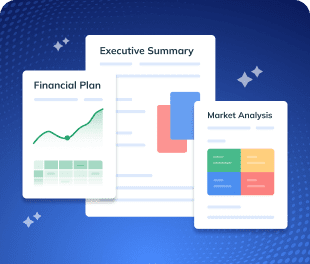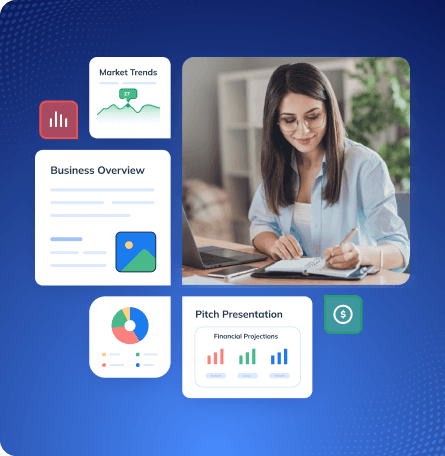You’re finally starting your hotshot trucking business and ready to hit the road.
But before you start investing resources, you need to ensure that your business will be profitable in the long run. And, only a solid business plan can assure that!
It helps you get clear on your goals, map out your day-to-day operations, manage your costs, and understand how much you need to earn to stay on track.
Instead of running on guesswork, you’ll move forward with direction, confidence, and a clear action plan.
Don’t know how to write one?
This hotshot trucking business plan template will guide you thoroughly.
Why do you need a business plan for hotshot trucking?
A hotshot trucking business plan is basically your roadmap to success. If you’re looking to break into the hotshot trucking industry, a business plan is a must-have tool.
Here’s why you need to write one for your business:
Gives you clear direction
Writing a business plan helps you organize your business ideas on paper and outline your short-term and long-term goals.
It also lets you clearly define what kind of loads you’ll haul, which regions you’ll cover, your target clients, pricing strategy, marketing efforts, and income projections. It acts as your go-to guide when there’s a lot going on.
Attracts lenders and builds trust
Many lenders and leasing companies are cautious when it comes to new hotshot trucking businesses. But a solid hotshot trucking business plan increases trust, shows you’ve done your research, and has a clear strategy to make money.
Helps you stay on top of legal requirements
The hotshot trucking business world comes with its own set of rules and regulations. A business plan helps you outline how you’ll stay compliant.
Whether it’s getting your Department of Transportation (DOT) number, maintaining proper insurance, or following hours-of-service rules, it’s all part of the bigger picture.
Prepares you for roadblocks
Let’s face it—things don’t always go as planned in trucking. Fuel prices rise, trucks break down, and some weeks are slower than others.
Having a business plan lets you think through these problems ahead of time and come up with backup plans. That way, you’re not stuck when things get tough.
How to draft a hotshot trucking business plan?
Here are the steps you need to follow to write a hotshot trucking business plan:
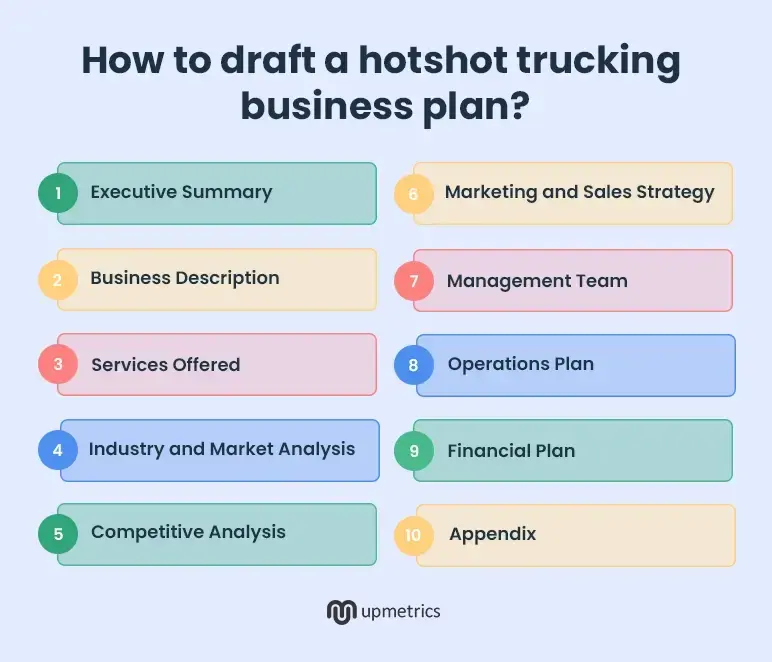
1. Executive Summary
The executive summary is a short and clear overview of your entire hotshot trucking business plan. It gives readers a quick idea of what your business is about and encourages them to read the full plan. So it’s important to keep it sharp and interesting.
A strong executive summary should answer all the key questions a potential investor or partner might have. For example:
- What’s the major goal of your business?
- What problems are your target audience facing? How will your business solve these challenges?
- What types of loads will you transport? What regions will you cover?
- Who is your target client—construction material companies, oilfields, manufacturers, or local businesses?
- How will you market your services and get regular loads?
- What are your startup costs, expected income, and long-term financial projections?
As you start writing, remember that the executive summary shouldn’t just summarize your business idea but the complete plan.
Try to keep it around 1 to 2 pages so that the lenders get the gist without feeling bored.
Say goodbye to boring templates
Build your business plan faster and easier with AI
Plans starting from $14/month

2. Business Description
Next, provide an effective business overview of your hot shot trucking company and give readers an in-depth understanding of its background. This is your chance to explain your own business concept in detail.
Consider including the following key components to make this section clear and complete:
- Type of business entity
- Location and service area
- Company’s vision and core values
- Name of owners or partners
- Background history
- Short-term and long-term objectives
- Regulatory requirements
This section of the plan is dedicated to your potential investors and lenders to understand exactly what your company does and what its goals are.
3. Services Offered
Next, provide a detailed explanation of the hotshot trucking business services you’d like to offer. This section outlines the range of services and shows how they add value and help you stand out from others in the industry.
So, highlight the variety and reliability of your hotshot trucking service offerings, including the types of loads you’ll handle, pricing methods, and the benefits your services provide to customers.
For instance, you may offer the following services:
- Same-day or next-day delivery: Ideal for customers who need urgent transportation of tools, equipment, or materials.
- Regional LTL (less-than-truckload) hauling: Transport small or partial loads over distances typically under 800 miles.
- Agricultural supply transport: Move feed, fencing materials, small equipment, or other farm-related items to rural or remote locations.
Here’s a simple example of hot shot trucking service that you can refer to for better clarity:
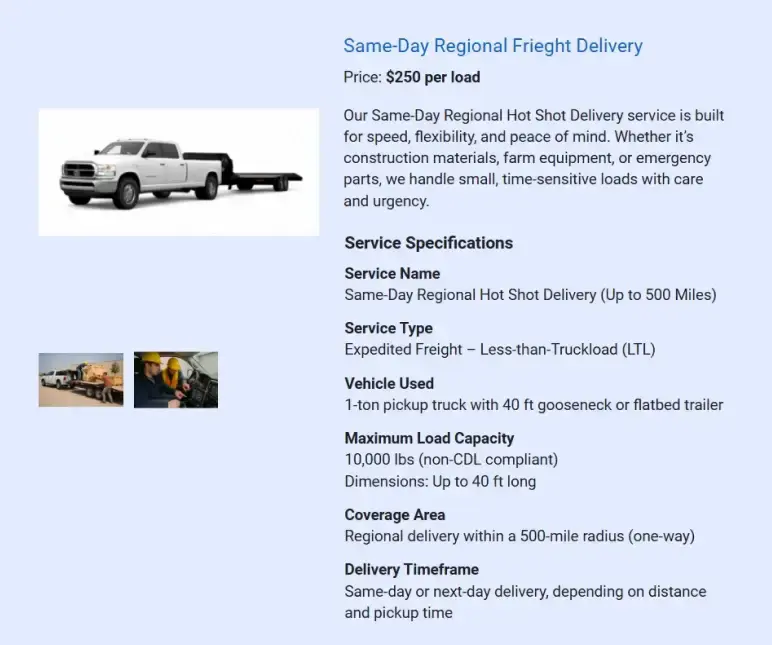
This section helps potential customers and investors clearly see what your hotshot trucking company will offer—and why it’s worth choosing you over others.
4. Industry and Market Analysis
The market and industry analysis allows you to better understand the external business environment or sector in which your hotshot trucking company intends to operate.
It provides valuable insights into the demand for expedited freight delivery, the competition in your region, current industry trends, potential challenges, and growth opportunities. So, it’s important to conduct thorough market research to launch your services successfully.
Here’s what you need to cover in this section:
- A brief overview of the hotshot trucking industry and its current trends
- Relevant statistics that reflect the industry’s size and demand
- Target customer segments and their service expectations
- Service gaps or customer pain points in the current market
- Current size and growth trends of the hotshot trucking industry
- Local activity that affects delivery needs
- Market saturation levels and areas with unmet demand
Try to keep this section clear, specific, and supported by research wherever possible. It lays the groundwork for your marketing, pricing, and service strategy.
5. Competitive Analysis
The competitive analysis section focuses on other hot shot trucking businesses in your area and explains how your business will stand out.
Your direct competitors are likely to be other local or regional hot shot trucking businesses offering similar services, such as quick deliveries, LTL (less-than-truckload) transport, and on-demand hauling using pickup trucks and trailers.
Indirect competitors might include large freight companies, traditional LTL carriers, or even businesses that use their own vehicles to move time-sensitive loads. Some customers may also choose to delay deliveries or bundle loads instead of paying for expedited service.
Still, your main focus should be on direct competitors, as they serve the same types of customers and offer similar delivery timelines and pricing structures.
Doing so will help you better understand the local market and figure out what your hotshot trucking company can offer that’s unique and better.
If required, perform a SWOT analysis to better assess your internal strengths and weaknesses as well as external opportunities and threats.
6. Marketing and Sales Strategy
Writing the marketing and sales strategy section means outlining how your hotshot trucking business will attract new customers and retain them longer. This part of your business plan focuses on practical strategies to grow your business both in the short term and over time.
To write this section effectively, break it down into the following parts:
Unique Selling Proposition (USP)
Start by explaining what makes your hotshot trucking business different from others. This is your Unique Selling Proposition (USP). Think about what you do better or differently than your competitors.
Your USP is what you want potential customers to remember you for. Make it short, clear, and focused on customer value.
Pricing Strategy
Next, describe how you’ll price your services in a way that keeps you competitive while also making a profit. As you write this part, research what other local hotshot operators charge and think about how your pricing compares.
Sales and Marketing Channels
Explain how you’ll reach your target customers. Focus on where your potential clients spend their time or search for delivery services. Pick the channels that make the most sense for your area and budget.
With a clear sales and marketing plan, you’ll be better positioned to grow your business, stand out from competitors, and build a steady base of loyal clients.
7. Management Team
As the name indicates, this management team section focuses solely on the people involved in your business and your day-to-day operations.
Hence, begin by introducing yourself. Share the responsibilities you manage and the role you play in the business, along with any relevant qualifications.
After that, talk about the team you have—like a part-time bookkeeper, a dispatcher, or a mechanic—mention them here. Explain what they do and what expertise they bring to the business.
You can also include a simple org chart to show the team structure and decision-making hierarchy. For example:
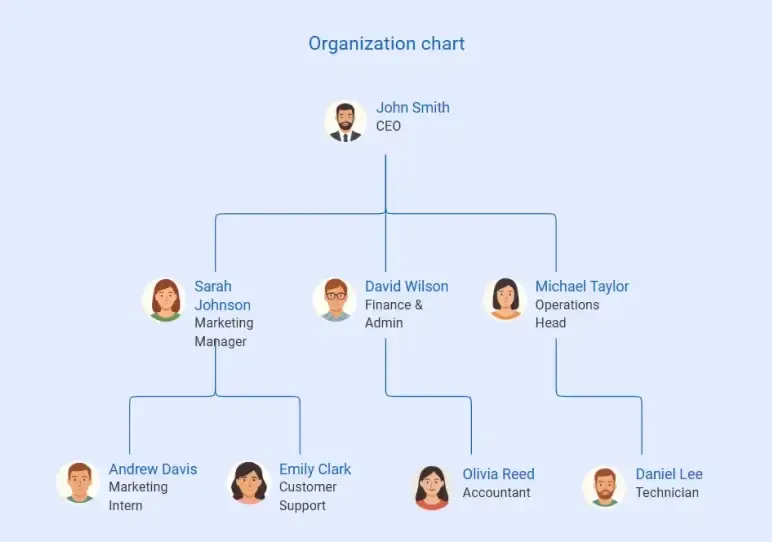
If there are any advisors or mentors involved in your business, mention them as well because it will only add to your authority.
8. Operations Plan
In this section, walk the reader through how your business operates behind the scenes.
It should reflect how your team manages deliveries from start to finish—from receiving a load request to completing the delivery and invoicing the customer.
To help you structure this clearly, we’ve listed a few elements you need to consider while writing a well-thought-out operations plan:
Team setup: Describe how your business is structured and mention how you’ll manage everything on your own or as a team.
Workflow: Outline how a delivery job flows from start to finish—like how you receive load requests, confirm job details, prepare your truck, and deliver it to the customer.
Tools and systems: List the tools you’ll use to keep the business running smoothly, like load boards, GPS apps, accounting software, and communication tools.
Time and task tracking: Explain how you’ll keep track of delivery times, job progress, stay on schedule, flag issues early, and manage multiple jobs efficiently.
Quality assurance: Describe how you’ll maintain service quality and customer satisfaction, as regular check-ins help you build trust and improve service over time.
In short, your operations plan is the day-to-day business routine, so keep it real and practical.
9. Financial Plan
Now it’s time to take a clear and realistic look at the numbers behind your hotshot trucking business.
This section outlines where your hotshot trucking business stands financially—and where it’s headed. Plus, if you’re planning to apply for a loan or bring in investors, a financial plan becomes non-negotiable as well.
When writing your financial plan, be sure to include the following key components:
- Startup Costs
- Projected Income Statements
- Projected Cash Flow Statements
- Projected Balance Sheets
- Break-even Analysis
- Funding Needs
To make your financial plan more attractive to potential investors or lenders, add simple tables, charts, or graphs. For example:
Income Statement
| Category | Year 1 | Year 2 | Year 3 |
|---|---|---|---|
| Total Loads | 400 | 500 | 600 |
| Revenue per Load | $450 | $475 | $500 |
| Gross Revenue | $180,000 | $237,500 | $300,000 |
| Fuel Costs | $40,000 | $50,000 | $60,000 |
| Maintenance & Repairs | $8,000 | $9,000 | $10,000 |
| Insurance | $9,000 | $9,500 | $10,000 |
| Permits & Licensing | $3,000 | $3,200 | $3,500 |
| Tolls & Misc. | $2,500 | $2,700 | $3,000 |
| Marketing | $2,000 | $3,000 | $3,500 |
| Loan/Lease Payments | $25,000 | $26,000 | $27,000 |
| Admin/Office Expenses | $1,500 | $1,800 | $2,000 |
| Total Expenses | $106,000 | $110,200 | $117,000 |
| Net Profit | $74,000 | $127,300 | $183,000 |
Cash Flow Statement
| Category | Year 1 | Year 2 | Year 3 |
|---|---|---|---|
| Opening Cash Balance | $0 | $74,000 | $201,300 |
| Cash Inflows | |||
| Revenue from Loads | $180,000 | $237,500 | $300,000 |
| Total Inflows | $180,000 | $237,500 | $300,000 |
| Cash Outflows | |||
| Fuel Costs | $40,000 | $50,000 | $60,000 |
| Maintenance & Repairs | $8,000 | $9,000 | $10,000 |
| Insurance | $9,000 | $9,500 | $10,000 |
| Permits & Licensing | $3,000 | $3,200 | $3,500 |
| Tolls & Miscellaneous | $2,500 | $2,700 | $3,000 |
| Marketing | $2,000 | $3,000 | $3,500 |
| Loan/Lease Payments | $25,000 | $26,000 | $27,000 |
| Admin/Office Expenses | $1,500 | $1,800 | $2,000 |
| Total Outflows | $106,000 | $110,200 | $117,000 |
| Net Cash Flow | $74,000 | $127,300 | $183,000 |
| Closing Cash Balance | $74,000 | $201,300 | $384,300 |
Balance Sheet
| Category | Year 1 | Year 2 | Year 3 |
|---|---|---|---|
| Assets | |||
| Cash | $74,000 | $201,300 | $384,300 |
| Accounts Receivable | $3,000 | $4,000 | $5,000 |
| Truck & Trailer (Net Value) | $60,000 | $55,000 | $50,000 |
| Other Equipment | $5,000 | $6,000 | $7,000 |
| Total Assets | $142,000 | $266,300 | $446,300 |
| Liabilities | |||
| Loan Payable | $40,000 | $30,000 | $18,000 |
| Accounts Payable | $2,000 | $3,000 | $4,000 |
| Taxes Payable | $3,000 | $5,000 | $7,000 |
| Total Liabilities | $45,000 | $38,000 | $29,000 |
| Owner’s Equity | |||
| Retained Earnings | $40,000 | $114,000 | $230,000 |
| Owner Capital | $57,000 | $114,300 | $187,300 |
| Total Equity | $97,000 | $228,300 | $417,300 |
| Total Liabilities & Equity | $142,000 | $266,300 | $446,300 |
10. Appendix
Lastly, gather all the additional information or supporting documents that don’t fit into specific sections but support your business plan.
Consider adding the following items to your appendix:
- Legal documents
- Copies of any contracts or agreements
- Resumes of owners or key team members
- Sample marketing materials
- Customer testimonials or case studies
In short, a business plan appendix helps keep your plan clean and organized while still providing important documents that lenders, investors, or partners may want to see.
Download a free hotshot trucking business plan template
Ready to start writing your hotshot trucking business plan from scratch? But need a little guidance to get it right? You’re in the right place. Download our free hotshot trucking business plan PDF to get started today.
This free, investor-ready template is designed to guide you through every key section of your plan—from defining your services and target market to outlining your operations, marketing, and financial strategy. You can even customize it to match your business goals and growth plans.
The Quickest Way to turn a Business Idea into a Business Plan
Fill-in-the-blanks and automatic financials make it easy.
Summary
Let’s wrap up! You’ve now got a clear breakdown of what goes into a hotshot trucking business plan—plus a ready-to-use template to help you get started.
With this structure in place, turning your ideas into a practical, goal-driven plan should feel much more manageable. But if you’re short on time or want a faster way to create a polished, investor-ready business plan, try using Upmetrics now.
It’s an AI-powered business planning platform that takes the guesswork out of planning and helps you build a professional plan customized to your hotshot trucking business in just a few clicks.
